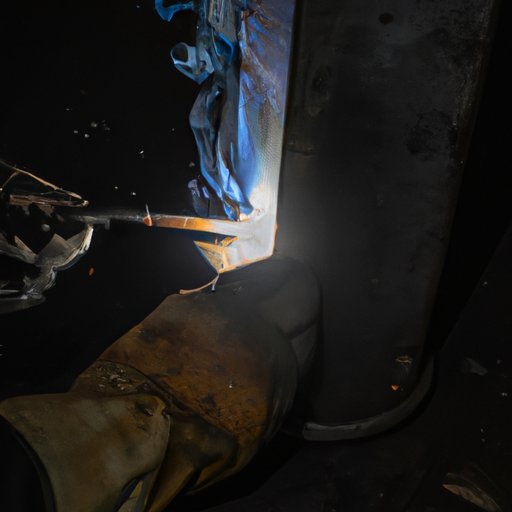I. Introduction
Welding cast iron can be a challenging task for even the most experienced welders. Cast iron is a fragile and brittle metal that presents unique challenges in the welding process. However, welding cast iron is essential in many different industries, making it a skill worth mastering. In this article, we will explore the weldability of cast iron, the methods, and best practices for welding it. This article caters to individuals interested in welding and intends to provide foundational knowledge to weld cast iron.
II. Understanding the Weldability of Cast Iron and Its Limitations
Cast iron is a group of iron-carbon alloys with a carbon content greater than 2%. The high carbon content gives it a unique set of properties that make it challenging to weld. One of the problems is its inherent brittleness, which causes it to crack easily under stress and exhibits low ductility. Cast iron’s other unique property is its low thermal conductivity, which makes it challenging to heat and cool evenly during the welding process.
Cast iron comes in different grades and types, each with its unique properties that can affect the weldability and the welding process. The most commonly used types include gray cast iron, ductile cast iron, white cast iron, and malleable cast iron.
Another limitation of welding cast iron without preheat or post-weld heat treatment is the high risk of cracking. If cast iron cools too quickly after welding, the weld may crack and fail. Preheat and post-weld heat treatment help to minimize the risk of cracking and ensure a stronger finished product.
III. What You Need to Know Before Attempting to Weld Cast Iron
Before welding cast iron, it’s essential to prepare the right tools and safety equipment. The necessary tools include a welding machine, high-quality welding rods suited for cast iron, and a suitable welding technique. Safety equipment should include protective clothing, gloves, respiratory protection, and proper ventilation equipment to minimize exposure to fumes.
There are several welding processes suitable for welding cast iron, including gas tungsten arc welding (TIG welding), gas metal arc welding (MIG welding), and shielded metal arc welding (Stick welding).
IV. Comparing Different Welding Methods for Cast Iron: Which is Best for You?
The choice of welding method depends on the type of cast iron and the welding job’s specific requirements. Each welding technique has its advantages and disadvantages that affect the finished product’s quality, durability, and cost. TIG welding, for instance, offers precise control over the weld pool and is suitable for welding cast iron that requires a high-quality weld. On the other hand, MIG welding is ideal for welding large areas quickly, making it a popular choice in automotive fabrication.
Stick welding, also known as SMAW, is the most traditional welding method and is generally the most cost-friendly. It is ideal for welding thicker cast iron where preheating and slower cooling rates are natural.
V. A Step-by-Step Guide: “How to Weld Cast Iron Like a Pro”
The welding process for cast iron involves several steps. Preparations before welding include cleaning, preheating, and post-weld heat treatment. During the welding process, the welder must use appropriate welding rods and techniques to ensure strong and durable welds. Here is a step-by-step guide to welding cast iron:
- Clean the cast iron thoroughly, removing all rust, oil, dirt, and other contaminants that can cause poor welding quality.
- Preheat the cast iron to at least 500 degrees F. This step reduces the risk of cracking and improves the molten pool’s fluidity.
- Start the welding process and use the appropriate welding technique and filler rod material for the job at hand.
- Cool the finished weld naturally and avoid water quenching. Preheat and post-weld heat treatment should be applied as necessary based on the type and thickness of cast iron in use.
VI. Common Mistakes to Avoid When Welding Cast Iron
Welding cast iron can be challenging, and some mistakes can lead to weak or failed welds. The following common mistakes can cause complications during welding:
- Underheating or overheating the cast iron
- Improper cleaning, resulting in contamination.
- Using incorrect welding rods and techniques
- Failing to preheat or post-weld heat treat certain cast iron types
- Failing to control the cooling rate effectively and especially not allowing enough cooling time before moving the cast iron
VII. Welding Cast Iron: Tips and Tricks for Success
To achieve successful welding results and a strong bond, it’s essential to follow these tips and tricks for welding cast iron:
- Always preheat the cast iron before starting the welding process. It helps to reduce the chances of cracking and ensures a better weld quality.
- Choose the right welding technique and suitable filler metal for the job type and type of cast iron you are welding.
- Properly clean and prepare the cast iron surface before welding. This protects the weld from contamination that may lead to poor weld quality and durability.
- Use a slow cooling rate to minimize the risk of cracking while the cast iron cools after welding.
- After welding, use a hammer or pry bar to ensure that the weld is strong and secure without cracks.
- Get professional assistance if you are new to welding or unsure about your skill level.
VIII. Conclusion
Welding cast iron can be quite challenging, but with the right knowledge, skills, and techniques, excellent results are possible. This article provides fundamental knowledge into the world of welding cast iron, including weldability, techniques, and best practices. By following the tips, tricks, and step-by-step guide we have outlined, you can gain confidence and enhance your skills as a welder in welding cast iron.
We encourage further reading and research about welding cast iron for anyone looking to learn more about this essential skill. Remember to stay safe while welding and use high-quality equipment and protective gear to protect yourself during the welding process.
